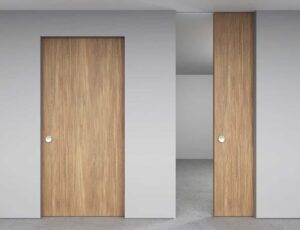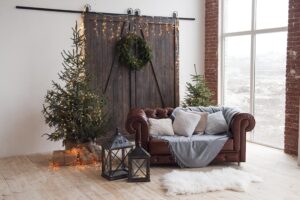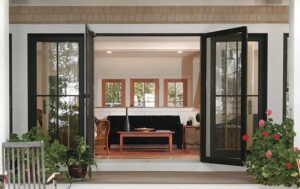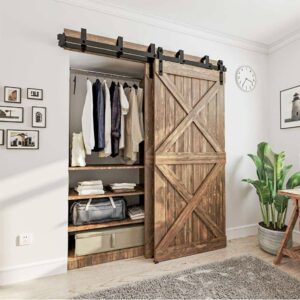Choosing a new door feels like a big decision. Two of the most popular styles you’ll come across are sliding doors and classic hinged doors. But which one is the right fit for your home, your budget, and your style?
In this comprehensive guide, we’ll break down everything you need to know about sliding doors versus hinged doors, so you can make an informed decision.
Sliding Door vs. Hinged Door: Head-to-Head Comparison
|
Feature
|
Sliding Doors
|
Hinged Doors
|
|---|---|---|
|
Space Needed
|
✅ Excellent. Requires zero swing space.
|
⭐ Fair. Needs clear floor space for the door to swing open.
|
|
Security
|
Good, with modern multi-point locking systems available.
|
Excellent, especially solid-core doors with a deadbolt.
|
|
Durability
|
Very durable, but depends on high-quality tracks and rollers.
|
Extremely durable and easy to repair due to a simple mechanism.
|
|
Cost
|
Can be more expensive, especially for large custom sizes.
|
Generally more budget-friendly for standard interior doors.
|
|
Energy Efficiency
|
Can be highly efficient with double-pane glass and good seals.
|
Can be highly efficient, with strong insulation and weatherstripping.
|
What is a Sliding Door?
A sliding door is a type of door that opens horizontally by sliding, usually parallel to a wall. These doors are mounted on a track and can be designed with one or more moving panels that slide past a fixed panel or into a wall cavity (known as a pocket door). They are most commonly seen as large glass patio doors, but their applications are incredibly versatile, ranging from closet doors to room dividers.
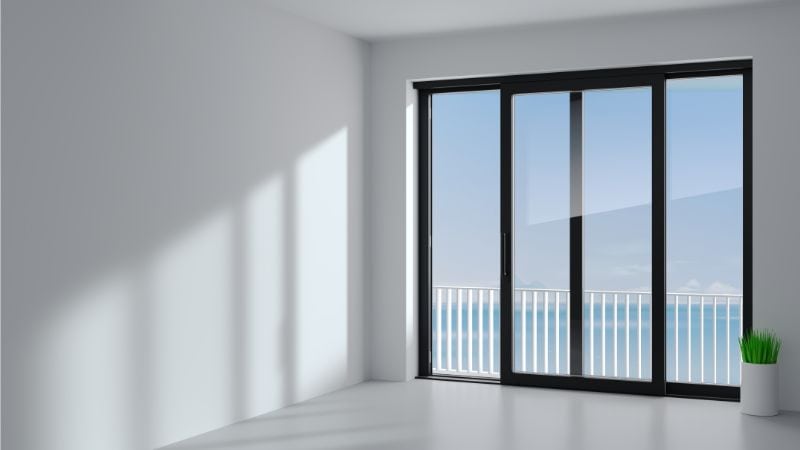
How Sliding Doors Operate
Sliding doors operate on a track system. The panels are fitted with rollers at the top or bottom (or both), which glide along the track. Modern sliding doors are engineered for smooth, effortless operation, allowing even very large and heavy glass panels to be moved with minimal force. This mechanism means they don’t require any swing space, making them a marvel of space-saving design.
Sliding Door Design Options
Sliding doors have evolved far beyond the standard patio door. Modern options include:
- Sliding Patio Doors: Often featuring large glass panels, they are perfect for creating a seamless transition between indoor and outdoor living spaces and maximizing natural light.
- Barn Doors: A popular interior design trend, barn doors slide along a track mounted above the doorway, offering a rustic or industrial-chic aesthetic.
- Pocket Doors: These doors slide into a compartment in the wall, disappearing completely when open. They are the ultimate space-saver for bathrooms, closets, and laundry rooms.
- Sliding French Doors: Combining the elegance of French doors with the functionality of a slider, these doors offer a classic look without the need for swing space.
What is a Hinged Door?
A hinged door is the most traditional and common type of door. It is attached to a door frame by two or more hinges, which allow the door to swing open and closed. Hinged doors can swing either inward or outward and are used for both interior and exterior applications, from grand front entryways to simple bedroom doors.
How Hinged Doors Operate
The operation of a hinged door is simple and timeless. The hinges, which are attached to both the door and the frame, act as a pivot point. When you push or pull the handle, the door swings on its hinges to open or close. The simplicity of this mechanism is one of its greatest strengths, contributing to its durability and ease of repair.
Hinged Door Design Options
Hinged doors are the chameleons of the door world, available in countless styles, materials, and finishes. Options include:
- Single-Leaf Doors: The standard for most interior rooms.
- French Doors: A set of two hinged doors that swing away from each other, creating a wide and elegant opening. They are a beautiful choice for patios, balconies, and connecting interior rooms.
- Panel Doors: Featuring a pattern of square or rectangular panels, these doors offer a classic, traditional look.
- Flush Doors: With a smooth, plain-faced surface, flush doors provide a clean, minimalist aesthetic perfect for modern interiors.
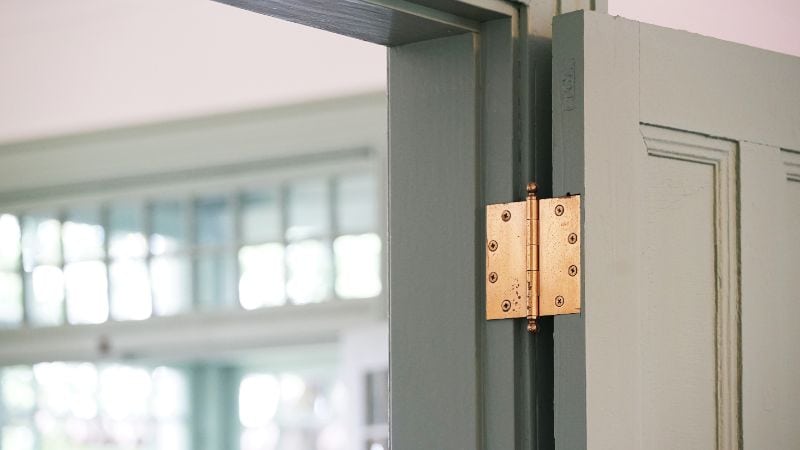
5 Factors to Consider Before Making Your Choice
1. The All-Important Space Factor
This is often the #1 reason people choose one door over the other.
- Sliding doors are the undisputed champion of small spaces. Because they don’t swing out, you can place furniture right next to them without blocking access. This is a game-changer for small bedrooms, tight hallways, or any room where you want to maximize every square inch.
- Hinged doors need room to breathe. You have to account for the “swing space”—that arc of empty floor a door needs to open. In a cramped room, this can seriously limit your furniture layout and make the space feel cluttered.
Winner for Space: Sliding Doors
2. Security: Keeping Your Home Safe
Feeling secure is non-negotiable.
- Hinged doors, especially exterior ones made of solid wood, steel, or fiberglass with a good deadbolt, are traditionally seen as the more secure option. Their sturdy frame and locking mechanism provide a strong barrier.
- Sliding doors used to have a reputation for being less secure, but that’s ancient history! Modern sliding glass doors have made huge security leaps. Look for features like multi-point locking systems, which secure the door at multiple places in the frame, and shatter-resistant glass.
Winner for Security: Hinged doors have a slight edge, but modern sliding doors are safer than ever.
3. Durability and Upkeep
A door is an investment, and you want it to last.
- Hinged doors are built to last. With just a couple of hinges and a latch, their mechanism is simple and incredibly reliable. Over many years, hinges might need tightening, but maintenance is typically minimal and cheap.
- A sliding door’s longevity comes down to its hardware. The key is the quality of the rollers and the track. A high-quality system will glide smoothly for decades, but you do need to keep the track clean from dirt and debris to prevent issues.
Winner for Durability: Hinged doors, for their sheer simplicity and time-tested design.
4. Cost Considerations: What’s the Budget
- The cost of a sliding door can vary widely based on size, material, and features. A large, multi-panel, energy-efficient sliding glass door will be a significant investment. Installation can also be more complex, especially for pocket doors, which require opening up a wall.
- Standard interior hinged doors are generally one of the most affordable options. However, the price can increase significantly for custom designs, high-end materials like solid wood, or elaborate styles like ornate French doors. Installation is typically more straightforward and less expensive than for sliding doors.
5. Energy Efficiency: Keeping Your Home Comfortable
- Modern sliding glass doors have made huge strides in energy efficiency. Look for options with double or triple-pane glass, low-E (low-emissivity) coatings, and argon gas fills. These features help to insulate your home, reducing heat transfer and lowering your energy bills. A tight seal is crucial, and high-quality weatherstripping around the frame will prevent drafts.
- Hinged doors, particularly exterior ones, can be highly energy-efficient. A solid-core or insulated-core door provides a strong thermal barrier. The key to their efficiency lies in the seal. A well-fitted hinged door with quality weatherstripping and a good threshold will create an airtight seal, effectively preventing air leakage.
So, Which Door Should You Choose?
As you can see, there’s no single “best” door – only the best door for you.
You should choose a SLIDING DOOR if:
- You are short on space.
- You want to maximize natural light and enjoy your views.
- You love a modern, open, and minimalist aesthetic.
You should choose a HINGED DOOR if:
- You have plenty of space for the door to swing open.
- You prefer a classic, traditional look.
- You want the widest possible variety of styles, materials, and hardware.
Making the right choice transforms your home. We hope this guide has made that choice a little bit easier.
Have more questions or ready to find the perfect door for your project?
Contact us today to speak with our door experts and find the perfect solution for your project.
Frequently Asked Questions (FAQ)
1. Which door is more secure, sliding or hinged?
While a solid hinged door with a deadbolt is traditionally considered very secure, modern sliding doors now offer comparable safety. Features like multi-point locking systems and laminated glass make them a secure option. For either choice, the quality of the lock is the most critical factor.
2. Are sliding doors a bad idea in cold climates?
This is a myth. Modern, high-quality sliding doors are built with energy efficiency in mind, featuring double or triple-pane glass and advanced weatherstripping to provide excellent insulation, making them perfectly suitable for cold climates.
3. Which door is cheaper, a sliding or a hinged door?
A standard interior hinged door is typically the most budget-friendly choice. However, when comparing high-end models, the prices for sliding and hinged doors (like solid-wood French doors) can be very similar.
4. Can you replace a hinged door with a sliding door?
Yes, this is a popular and straightforward renovation. The easiest way is to install a sliding barn door that runs on a track above the doorway. A pocket door that slides into the wall is also an option, but it requires more complex wall modifications..
5. Which door type is better for noise reduction?
A solid-core hinged door usually offers the best noise reduction due to its mass and the tight seal it forms with the frame. However, a quality sliding door with double-pane glass also provides significant sound dampening.
6. Do sliding doors require a lot of maintenance?
No, they are designed to be low-maintenance. The most important task is to keep the track clean from dirt and debris to ensure the door glides smoothly. A quick vacuum now and then is all that’s needed.


